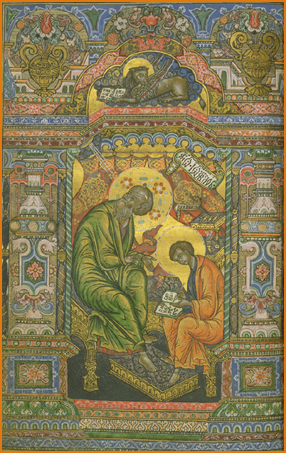| |
 |
|
|
| Photographic
Services & Permissions |
 |
 Gospels
for a Russian National Saint? Gospels
for a Russian National Saint? |
Evangelie [ The Gospels]
Moscow : [A. M. Radishevskii.M., typographer; ], 1606
NYPL, Spencer Collection
This copy of the Gospels was printed by the Belarusan typographer
Anisim Radyshevsky (in Russian, Anisim Radishevskii, ca. 1560-ca.
1631). The ornamentation and coloration of this leaf, showing the
evangelist
John dictating his Gospel to Saint Prochoros on Patmos Island, suggest
the stylistic "Orientalism" of Muscovite design in the
17th century. Few extant copies of this work have such brilliant
hand-coloring,
suggesting that the Library's copy may originally have belonged
to the contemporary Moscow Patriarch (later Saint) Germogen (ca.
1530-1612).
It was St. Irenaeus who first adopted the four sacred creatures
of Ezekiel's vision as the symbols of the four evangelists, attributing
the lion to St. John and the eagle to St. Mark (in the west,
the opposite attribution was adopted). Both traditions must have
co-existed in Russia, until, toward the end of the 16th century,
the western attribution of the eagle replaced the lion on icons
of St. John the Evangelist.
 |
|














